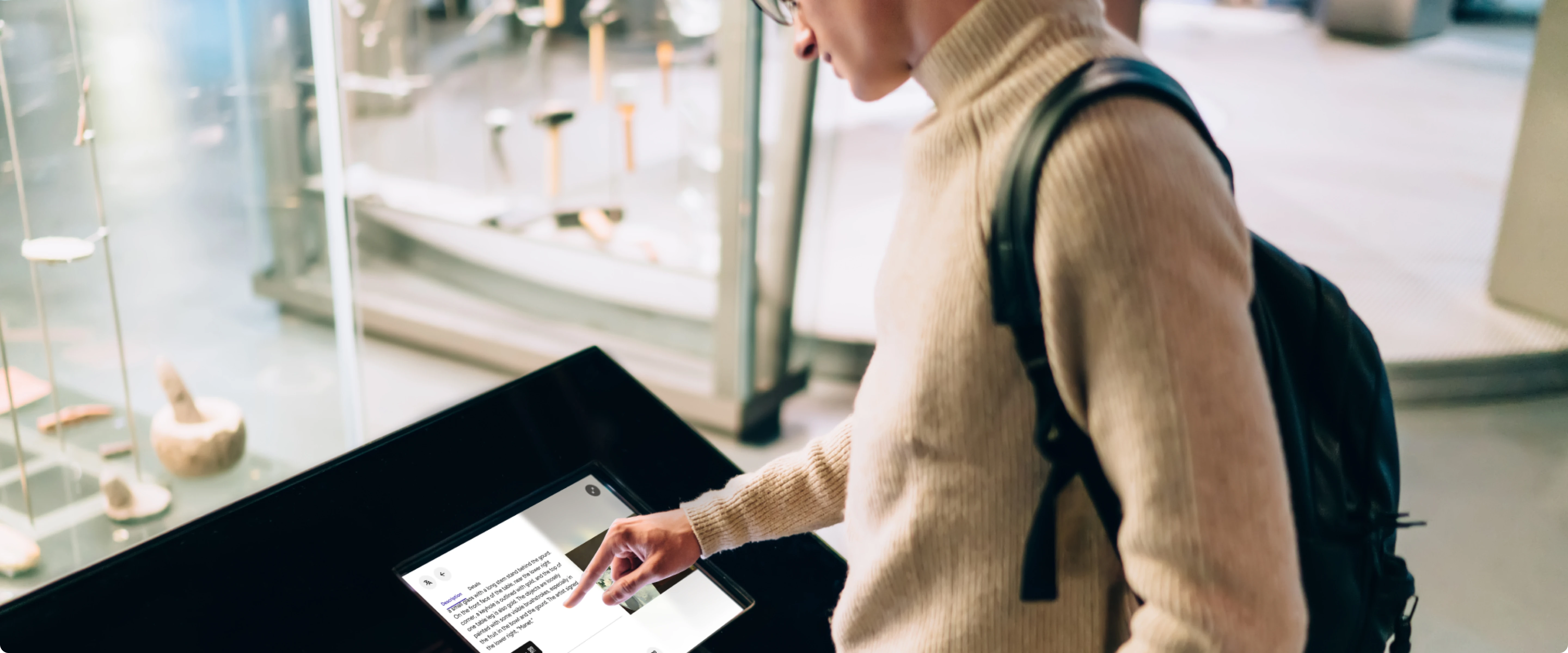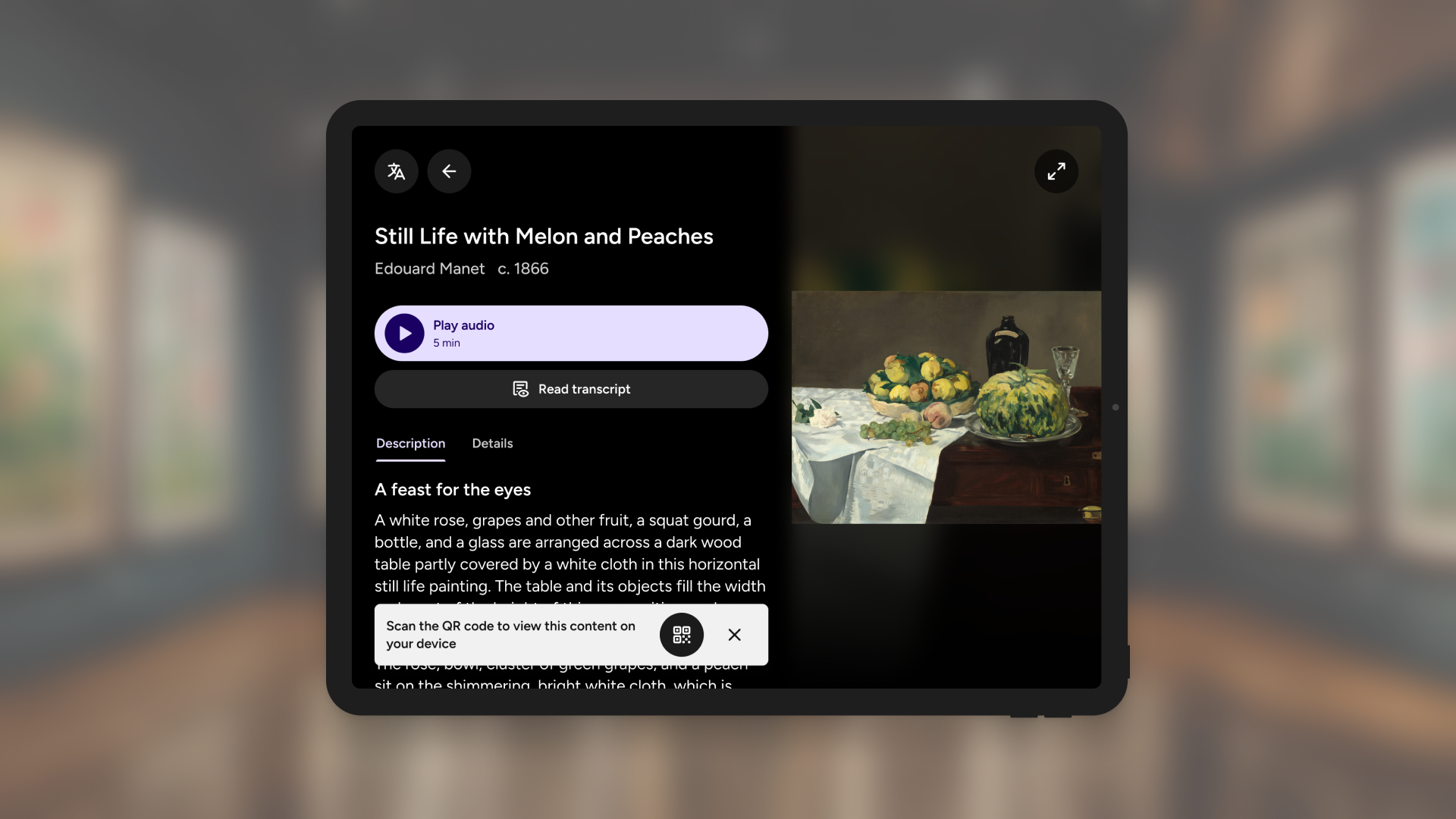
Why we’re building Digital Object Labels
What happened when we looked into kiosks

What happened when we looked into kiosks
Through our ongoing research conversations we’ve seen a noticeable shift in what cultural institutions are asking for when it comes to digital tools. More and more, our customers are looking for a unified content management system—one that can support all of their digital endpoints, from mobile guides to in-gallery interactives. At the same time, there’s a growing appetite for off-the-shelf products, provided they can be aligned with the strategic vision and goals of the organisation.
We found ourselves asking: how can we help? We already have a robust, adaptable back-end in place. Empower is currently being used across a wide range of cultural venues to support Bring-Your-Own-Device (BYOD) museum guides. Could we extend that same infrastructure to support other formats?
We started by mapping out the options:
- Large wayfinding kiosks to help people orient themselves in unfamiliar spaces
- Digital signage to highlight events, promotions, and temporary exhibitions
- Collection browsers for discovery at scale
- And digital object labels—kiosk-based experiences designed to provide deeper insight into individual objects in the collection
Each one had merit. But to decide where to focus first, we needed to understand which of these would solve the most pressing problems, and deliver the most value. That’s where our research began.
The result: accessible digital labels
Digital labels rose to the top for two key reasons: visitor benefit and institutional readiness.
In around 19% of the procurement documentation we reviewed, the organisation was actively seeking a kiosk-based object label solution. In many cases, institutions had already digitised large parts of their collection—sometimes with significant investment and effort—but lacked an elegant, accessible way to make that material visible in the gallery.
As one museum professional put it:
"We are constantly trying to digitise the collections, and make things as accessible as possible."
And while static wall labels still have their place, digital labels offered some very clear wins: multilingual support, the ability to display media-rich content, easier updates, and the ability to support accessibility objectives without adding more physical infrastructure to galleries.
Why our approach is a bit different

Place-based thinking is our DNA
Our object labels are automatically generated from Pladia’s location-based system. That means a kiosk can be deployed quickly—within moments, not months—and will automatically display all the items within a zone selected by the user. This helps maintain a visual link; making it easier for visitors to find the object they are interested in on the screen of the kiosk.
To avoid issues with crowding or limited time at the kiosk, visitors can seamlessly hand off content to their personal devices via a QR code, powered by the Empower mobile experience.
Compact and offline-ready
Retrofit installations of kiosks are often limited by infrastructure: outlets, Wi-Fi stability, and wall or floor space. We heard clearly that Wi-Fi is not always reliable:
"Yes we have Wi-Fi, but we’ll find that it disconnects itself during the day. Which is less than ideal."
So our solution is screen-agnostic and works offline. It can run on anything from a compact tablet to a larger touchscreen, and it’s browser-based—meaning museums can repurpose existing hardware instead of buying new. It’s also incredibly resilient when internet is patchy, allowing displays during temporary network outages. Content updates automatically sync as soon as connectivity is restored without disrupting a visitor’s session.
Better usability = bigger teams
We heard that sometimes new software platforms created work rather than alleviating it, as they’re not always usable by the staff who need to manage them day to day.
A better interface doesn’t just improve workflow—it broadens participation. With a well-designed system, non-technical teams like marketing and education can take ownership of kiosk content, reducing reliance on the limited capacity of the IT or digital team.
Accessibility is core, not an afterthought
Whether the goal is to support screen readers, offer multi-lingual support, or provide alternative formats for visual or cognitive access, the importance of accessibility came through strongly in our research.
For many institutions, accessibility and broadened participation weren’t just a bonus—it was the reason to implement digital object labels in the first place.
"Digital object labels, with accessibility. You can’t have one without the other."
"We get a lot of overseas visitors as well, so it would be really helpful to have options so that people can see to themselves—even if there is a language barrier."
By furnishing each individual digital label with QR codes that links to the relevant content in Empower, users can access specific kiosk content on their personal device, which has a broad range of accessibility features built in.
Hardware-agnostic by design
Finally, institutions told us that hardware flexibility was critical. Some had specific preferences for device types such as Brightsign, while others had spare equipment they were keen to repurpose. In a sector where budgets are tight, reusing what you have makes sense.
Our object label solution is hardware-agnostic and browser-based, so it works across any device with minimal setup. It’s one less technical decision to worry about.
Building with the sector, for the sector
We didn’t set out to build kiosks. We set out to solve a problem, and this is where the research led us. In every conversation, we were reminded that simple, reliable, well-integrated tools are more valuable than bespoke systems that are hard to maintain.
"Creating your own software and troubleshooting it and keeping it is going to be a very, very ambitious enterprise, and museums are generally not so overflowing with staff with free time."
We’re excited to share more about our digital object label work as it develops. Like all of our projects at Pladia, it’s a tool shaped by listening: to visitors, to practitioners, and to the institutional needs that often go unseen.
Check out what's available today here.